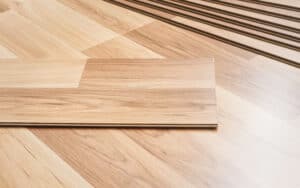
Paint doesn’t always come cheap.
As such, if you just finished an interior painting job, you may have some paint left over.
You might also be considering painting the exterior of your home.
Since you have some interior paint left over, you may wonder if you can use that to paint the exterior of your home.
It may save you some money, but it’s worth knowing whether it’s a good idea to use interior paint outside or not.
Can You Use Interior Paint Outside?

No, you cannot use interior paint outside.
Exterior paint contains many additives that make it ideal for outdoor use.
Interior paint lacks those additives.
Instead, it contains other additives that make it ideal for problems that might occur inside.
For example, smudging and smearing are problems interior paint must face.
When people run their hands across the wall, they can leave marks behind.
Interior paint helps reduce the smudges by making it so the paint doesn’t catch the dirt.
Exterior paint has additives geared toward reducing damage caused by the environment.
Since interior paint lacks those additives, it wouldn’t last long outside.
You could paint the exterior of your home or deck with interior paint, but it wouldn’t last long.
What Happens If You Use Interior Paint Outside?

If all you have is interior paint, you may feel tempted to use it outside.
You may need to repaint a part of your siding or touch up your deck.
You might even have a few simple crafts like planters that you want to paint.
The last thing you should use is interior paint.
When you use interior paint outside, several problems occur.
Here are some of the problems you can encounter if you use interior paint outside.
1. Streaky Paint

Interior paint typically isn’t waterproof.
Paint used in a bathroom or kitchen might have some waterproofing to it, but by and large, interior paint isn’t waterproof.
As such, as soon as the first rainfall occurs, your paint is going to start streaking.
The water is going to interact with the pigments and cause them to lose adhesion to the surface.
As a result, the paint starts to wash away and streak downwards.
You could end up with a huge mess.
Essentially, you’d end up wasting your interior paint since it’d slowly wash away with time anyway.
Any paint that remains will look streaky and unattractive.
2. Mold

Another problem your interior paint will encounter outside is mold.
Interior paint typically doesn’t have mold protection added to its formula.
As such, when the paint becomes wet, there’s a good chance that mold will start to grow on it.
You may discover that the deck you just painted with interior paint is becoming moldy.
You may notice your siding becoming moldy because you used interior paint.
Since mold can damage organic materials like wood, it’s not going to be good if you have mold on your deck and siding.
There’s a good chance the mold will spread and potentially access the inside of your home, too.
Besides being a danger to your home, mold doesn’t look great.
Your deck and siding may look far older than it actually is due to the mold.
You shouldn’t use interior paint outside because mold can grow on it.
3. Fade

Interior paint also lacks UV protection.
When you paint your deck or siding with interior paint, you’re going to notice its color fade.
UV can break the chemical bonds that hold pigments together.
Without a pigment there, you don’t see any color.
Using interior paint outside can be a waste of time since the color will just fade with time, anyway.
You’ll need to buy new paint and paint it all over again in a short amount of time.
Fading paint can also make your deck or siding look older than it is.
As such, you should stay away from using interior paint outside.
What’s The Difference Between Indoor Paint And Outdoor Paint?

To understand why you should avoid using interior paint outside, it helps to know the key differences between indoor paint and outdoor paint.
Some differences include the amount of oil in the paint, the flexibility of the paint, certain additives in the paint, and the fact that one releases volatile organic compounds over time.
Let’s look at these differences in more detail.
1. Exterior Paints Contain More Oil Than Indoor Paint
One of the primary differences between indoor paint and outdoor paint is that exterior paint contains more oil than indoor paint.
Outside paint tends to be an oil-based paint.
It works better, and there’s less harm in using it outside.
You might find that oil-based paint offers a more vibrant color.
When used inside, oil-based paint can look streaky and is messy to use.
It’s much better suited for outdoor use.
Between interior and exterior paint, exterior paint tends to contain the most oil.
2. Exterior Paint Is More Flexible
Because outside paint is sometimes oil-based, it’s also a bit more flexible.
This is important because it means it’s able to tolerate outdoor elements better.
In particular, it’s important for temperature changes.
Hot temperatures can make the wood of your home expand.
Since exterior paint is flexible, it can stretch with it.
During cold temperatures, the wood shrinks.
The flexibility of outdoor paint allows it to shrink with the wood.
That results in fewer cracks.
3. Exterior Paint Uses Fade-Resistant Additives
Exterior paint contains several different additives that you won’t find in interior paint.
One of those helps the paint resist fading.
These additives essentially keep the paint protected from UV rays.
Since outdoor paint is constantly exposed to the sun, it needs protection from ultraviolet light.
By having UV protection, it’s able to protect the chemical bonds within its pigments.
That makes the color of the paint last longer.
You’ll have to deal with fewer painting jobs when you use exterior paint outside.
4. Interior Paint Doesn’t Include Mold-Resistant Additives
Another major difference between interior paint and outdoor paint is that interior paint typically doesn’t have any mold-resistant additives.
As discussed earlier, there’s always a chance mold might grow on a surface if it contains organic material.
It feeds on it.
Exterior paint contains mold-resistant additives to keep mold from eating away at the paint and the surface below it.
Essentially, it can help protect your siding, deck, or other outdoor items from mold.
Interior paint won’t provide the same service in most cases.
Since it typically doesn’t have to deal with mold, it doesn’t contain any mold-resistant additives.
5. Interior Paint Is Often Washable
One element that interior paint tends to have that exterior paint doesn’t is its ability to be washed.
Interior walls can become grubby.
Even if they’re protected against smudges, there’s always a chance that some sort of ink or crayon is going to end up on the wall.
Interior walls have additives in them that allow homeowners to wash them without worrying about the paint washing away, too.
That allows homeowners to easily clean their interior walls.
6. Exterior Paint Releases Volatile Organic Compounds
A final difference between exterior and interior paints is the fact that exterior paint tends to release volatile organic compounds over time.
Part of the reason that exterior paint releases volatile organic compounds is because of all the additives in it.
It’s safe to use this type of paint outside since it just releases into the atmosphere.
Inside, however, it’s stuck and has a higher chance of entering your body when you breathe.
Since VOCs can cause health problems, it’s best to avoid using exterior paint inside the home.



Leave a Reply